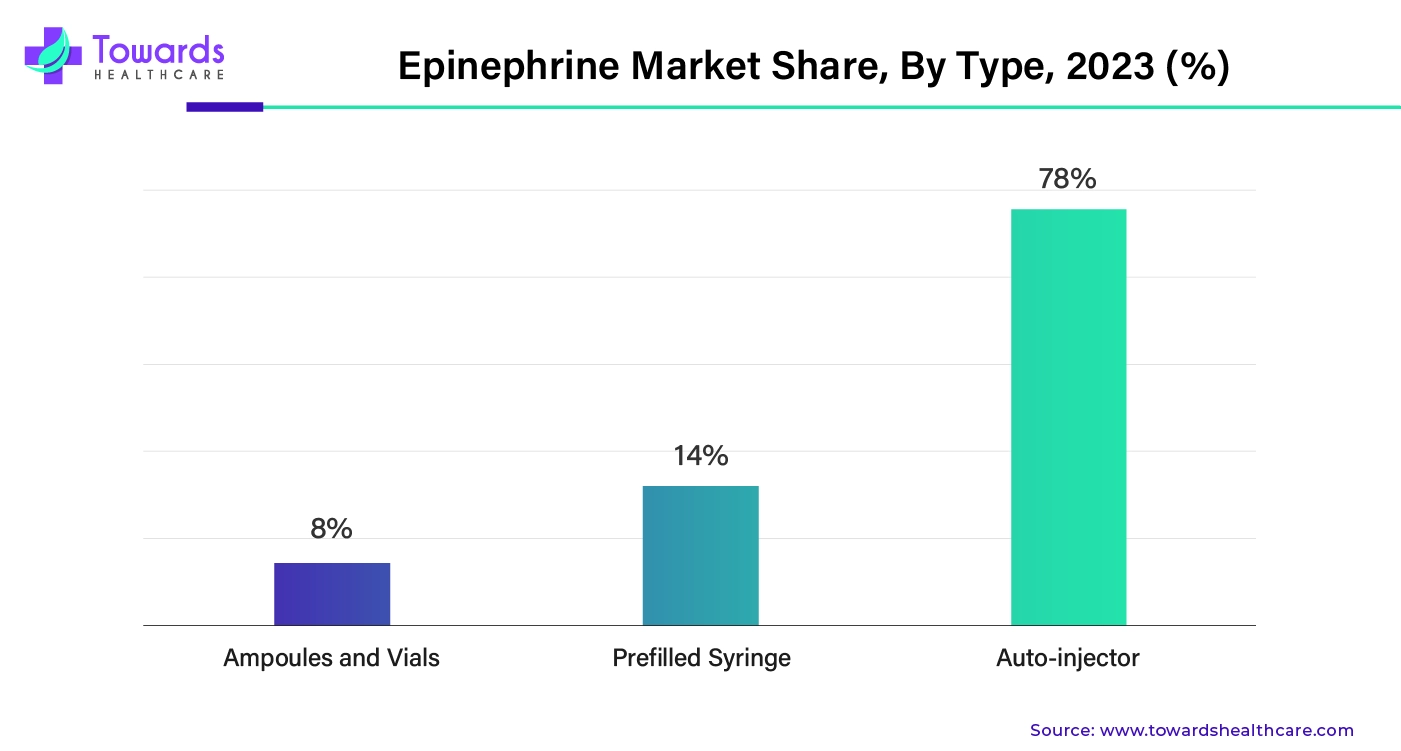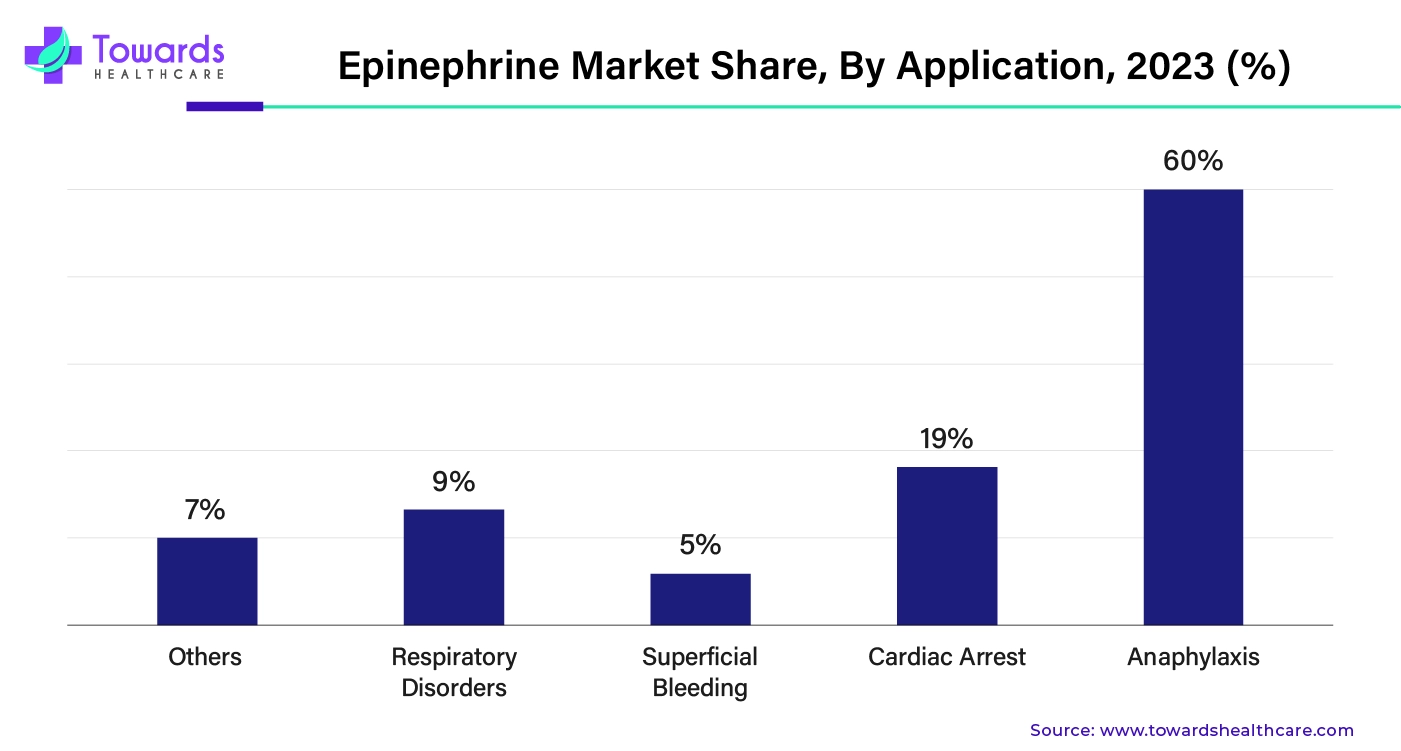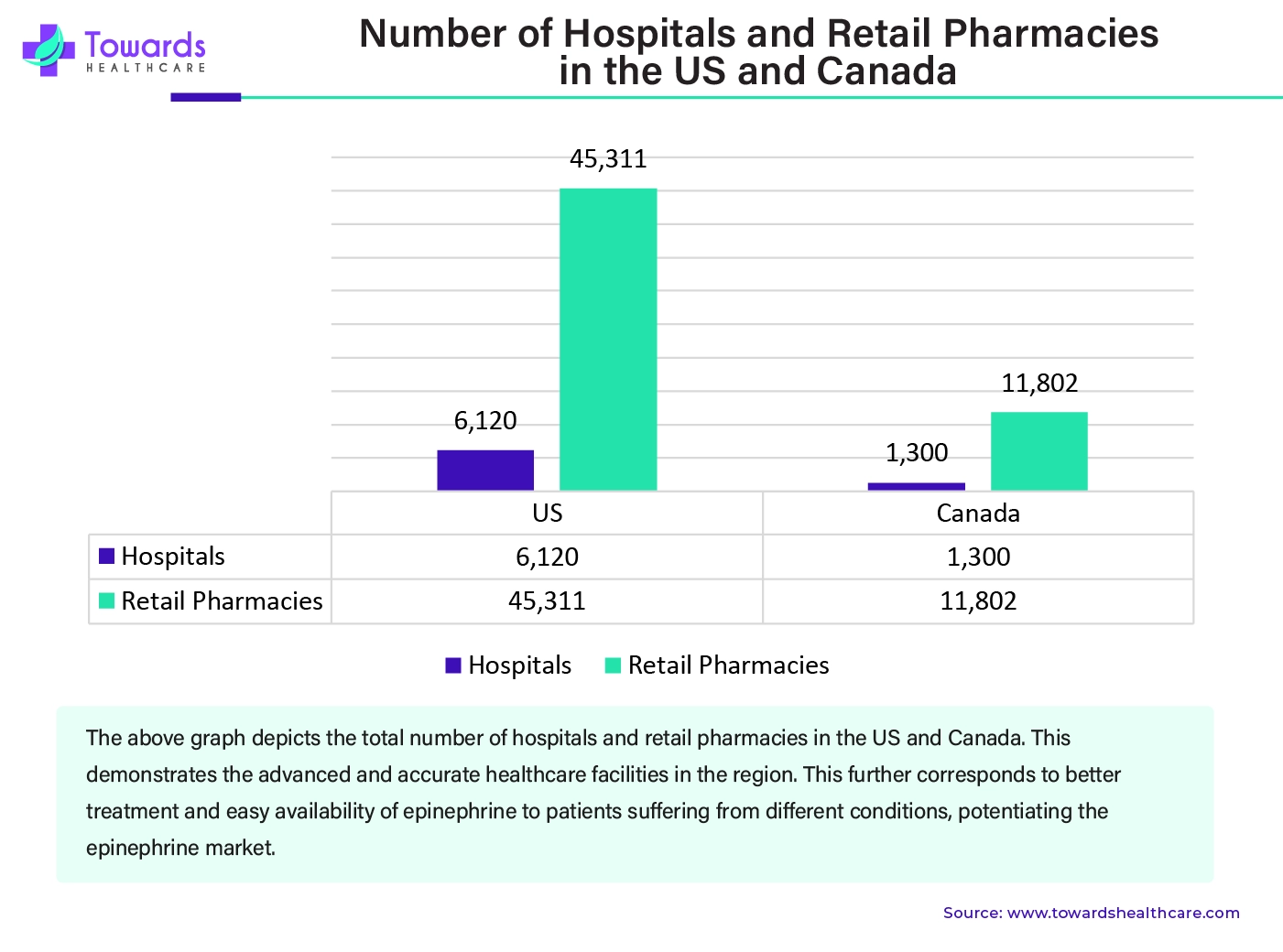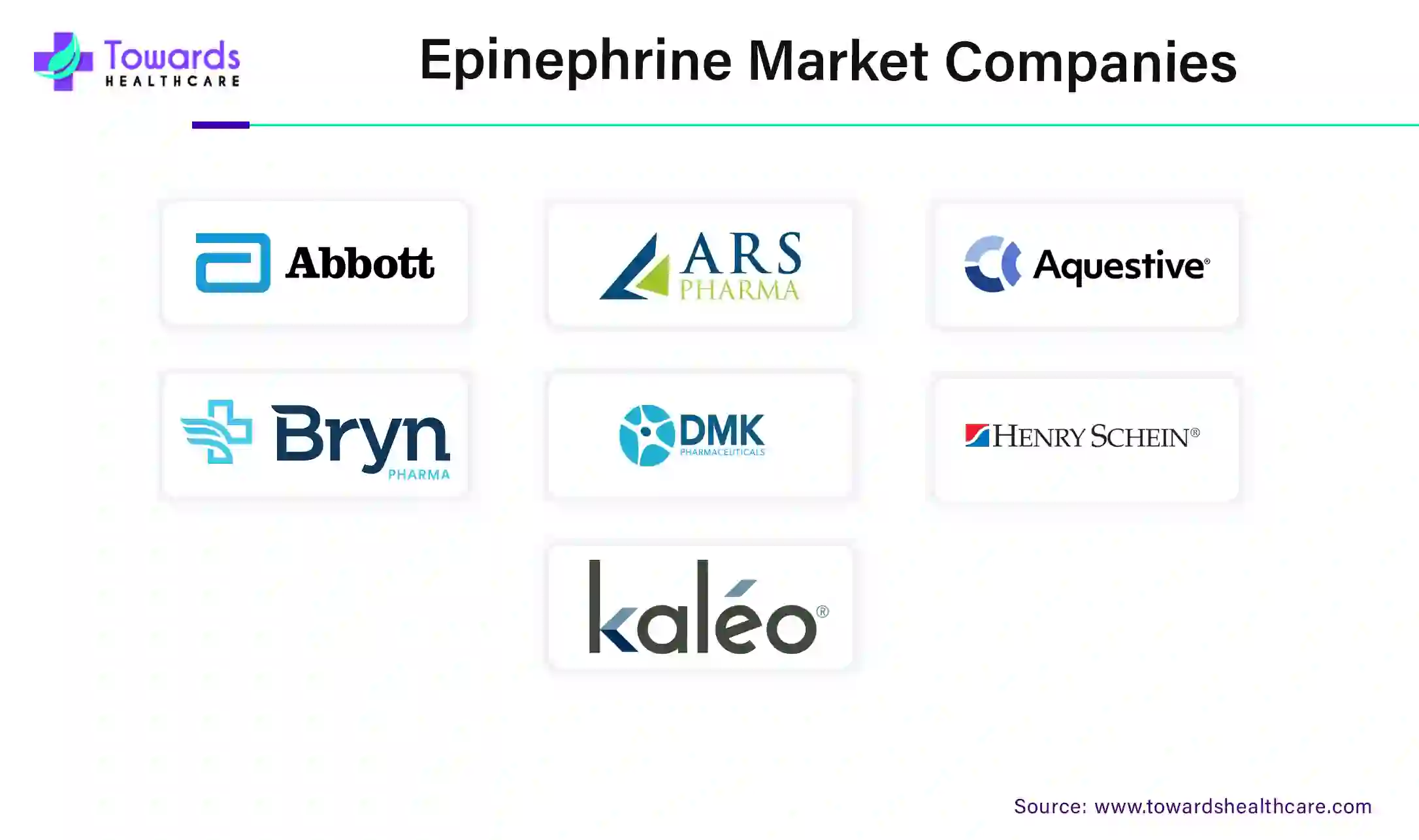January 2026

The epinephrine market was estimated at US$ 3.37 billion in 2025 and is projected to grow to US$ 7.51 billion by 2035, rising at a compound annual growth rate (CAGR) of 8.34% from 2026 to 2035.

| Key Elements | Scope |
| Market Size in 2026 | USD 3.65 Billion |
| Projected Market Size in 2035 | USD 7.51 Billion |
| CAGR (2026 - 2035) | 8.34% |
| Leading Region | North America by 36% |
| Market Segmentation | By Product Type, By Application, By Distribution Channel, By Region |
| Top Key Players | Abbott Laboratories, Amedra Pharmaceuticals LLC, ARS Pharmaceuticals, Aquestive Therapeutics, Bryn Pharma LLC, DMK Pharmaceuticals, Henry Schein, Kaleo, Inc., Nasus Pharma, Oval Medical Technologies Ltd., Pfizer, Sanofi S.A., Teva Pharmaceuticals, Verus Pharmaceuticals, B.V., Viatris, Inc. |
Epinephrine, or adrenaline, is a hormone and neurotransmitter released by the body during a fight-or-flight response since it is a part of the sympathetic nervous system. As a neurotransmitter, it plays a role in metabolism, concentration, panic, and excitement. As a hormone, it is released in response to stress conditions of the body. It is commonly used as a medication or hormone. Epinephrine is injected in individuals having low levels of the hormone. Low levels of epinephrine cause anxiety, headaches, depression, sleeping disorders, hypoglycemia, and changes in blood pressure and heart rate. It is approved for emergency treatment of allergic reactions like type I hypersensitivity reactions, including anaphylaxis, induction, and maintenance of mydriasis during intraocular surgeries and hypotension due to septic shock. Additionally, it is used in several cardiac disorders like ventricular fibrillation, pulseless ventricular tachycardia, asystole, and pulseless electrical activity (PEA). It is also used in severe asthma exacerbations unresponsive to standard treatment.
Artificial Intelligence (AI) revolutionizes the healthcare sector, enabling rapid growth and advanced treatment. AI and machine learning algorithms can enable the detection of anaphylactic episodes and other disorders, improve diagnostic accuracy, and provide personalized treatment. AI can also aid in research and development, facilitating superior outcomes. AI can help in developing novel drug delivery systems for epinephrine. The integration of AI can provide faster and more targeted drug delivery in diseased patients. Moreover, owing to the higher number of clinical trials evaluating the role of epinephrine in several disorders, AI and ML can also help in the execution and analysis of clinical trial data for better experimental output. Hence, AI uses computer-aided learning and extensive datasets to simulate human intelligence and use its capacity for decision-making and problem-solving.
The rising incidences of acute disorders globally necessitate the use of epinephrine for their treatment. Epinephrine is widely used as a first-line treatment for anaphylaxis. It has been reported that 1 in 20 Americans, i.e., 1.6% to 5.1% of the US population, experience anaphylaxis, with around 225 fatalities annually. Several pharmaceutical companies are investigating novel devices and drug delivery systems of epinephrine for anaphylaxis. Similarly, epinephrine is also widely used to treat sepsis, unresponsive to standard treatment. Approximately 48.9 million cases of sepsis are reported, with around 11 million (20%) sepsis-related deaths globally. Another acute disorder for which epinephrine is used is severe acute asthma. Asthma affects over 260 million people and is responsible for over 450,000 deaths each year worldwide. Patients are advised to carry epinephrine to provide emergency relief if they have difficulty breathing due to severe asthma attacks.
The primary challenge in the market is its large-scale availability. The disrupted supply chain in several countries combats the supply of epinephrine or its drug-delivery device. Supply chain issues are mainly caused by increased demands or manufacturing delays by contract manufacturing organizations. Another major challenge for the epinephrine market is its high cost. The average cost of an epinephrine injection is around $600 to $700, hindering its use by many low- and middle-income countries. Additionally, the stringent regulations by different regulatory agencies for the approval of epinephrine results in fewer products in the market.
Concerning the increasing incidences of acute disorders, several researchers and pharmaceutical firms are investigating the role of epinephrine. Epinephrine is officially approved for treating several disorders like allergic reactions, sepsis, intraocular surgery, asthma, respiratory disorders, and cardiac arrest by the US FDA. By conducting clinical trials, the researchers are evaluating the pharmacokinetic profile of epinephrine in different individuals for several disorders. They are also testing different drug delivery systems and accurate dosing regimens for enhanced delivery and better outcomes.
Moreover, the versatility of epinephrine potentiates its investigation in several other disorders. According to the data available on clinicaltrials.gov, a total of 2,025 clinical trial studies have been performed involving epinephrine as an intervention or treatment as of September 2024. Out of these, 434 studies are ongoing, bifurcated into 23 phase 1 studies, 59 phase 2 studies, 31 phase 3 studies, and 60 phase 4 studies. Out of the 2,025 studies, around 1,077 were completed, and 120 were terminated.
For instance,
How the Auto-injector Segment Dominated the Epinephrine Market?

The auto-injector segment accounted for a considerable share of 78% in the epinephrine market. An epinephrine auto-injector is a medical device that injects an appropriate dose of epinephrine inside a patient’s body. Auto-injectors are generally single-use, spring-loaded, disposable syringes. Patients usually prefer auto-injectors as they are easy to use and are intended for self-administration, eliminating the need for trained personnel. Epinephrine auto-injectors are widely used to reduce the effects of allergic reactions like trouble breathing, swelling of the face, lips, and throat, shortness of breath, lightheadedness, fainting, weak pulse, low blood pressure, or swollen tongue. Hence, auto-injectors are widely preferred during emergencies due to their ease of use and requiring no need for adjusting doses.
The Prefilled Syringes Segment is the Fastest-Growing
The prefilled syringes segment is projected to expand at the fastest rate in the epinephrine market in the coming years. An epinephrine pre-filled syringe is a manually injectable, single-dose syringe. This syringe is prefilled with a measured dose of epinephrine. They are widely preferred for cardiac arrest patients. Epinephrine administration can increase the child’s chances of survival after a cardiac arrest. Commercially available prefilled syringes enable direct delivery of a partial volume of epinephrine during pediatric resuscitation. According to a 2020 study published in the Journal of Thoracic Disease, epinephrine-prefilled syringes, when administered during cardiopulmonary resuscitation (CPR), may significantly improve the quality of CPR.
Why Anaphylaxis Segment Dominated the Epinephrine Market?

The anaphylaxis segment registered its dominance over the global epinephrine market share by 60% in 2023. The increasing incidences of severe life-threatening anaphylaxis reactions boost the market. Anaphylaxis is an acute, systemic, and severe allergic reaction caused by various allergens, including food products, drugs, insect venoms, or latex. Food allergies are the most common cause of anaphylaxis. The food products that cause anaphylaxis include peanuts, shellfish, milk, eggs, soy, wheat, and tree nuts. Penicillin is the most frequent cause of fatal anaphylactic cases among individuals.
Allergy can also occur due to latex from latex-containing rubber gloves commonly used in the healthcare sector. The rising prevalence of infectious diseases increases the use of latex gloves, which increases the incidences of anaphylaxis. Furthermore, anaphylaxis can also be caused by insect sting venoms. However, its incidences are low compared to the other three causes. Epinephrine is the first-line treatment for anaphylaxis. Epinephrine is generally administered through intramuscular injections. However, many researchers and pharmaceutical companies are evaluating its use as an intranasal spray.
The Cardiac Arrest Segment is the Fastest-Growing
The cardiac arrest segment is predicted to witness the fastest growth rate in the epinephrine market over the forecast period. Epinephrine produces beneficial effects in patients during cardiac arrest. It is primarily administered during cardiopulmonary resuscitation (CPR) to reverse cardiac arrest. Out-of-hospital cardiac arrest (OHCA) or sudden cardiac arrest is one of the leading causes of death worldwide. The global incidence of emergency medical services (EMS)-treated OHCA may range from 30 to 97.1 per 100,000 population. Healthcare professionals also use an automated external defibrillator (AED) to deliver an electric shock through the chest to the heart to restore a heartbeat. According to a 2021 study presented at the American Heart Association’s Symposium, epinephrine administration within four minutes after the first shock from an AED corresponded with a greater likelihood of an individual’s recovery.
Which Distribution Channel Type Segment Held the Dominating Share of the Epinephrine Market?

The retail pharmacies segment led the global epinephrine market share by 41%. Epinephrine is mostly used in emergencies like severe allergic reactions, severe asthma attacks, or sudden cardiac arrest. Hence, retail pharmacies are the easiest source of epinephrine injections during emergencies. This potentiates the growth of the retail pharmacy market. Additionally, the availability of generic medications, the presence of trained personnel, special discounts, and 24x7 facility make retail pharmacies a preferable choice. Additionally, retail pharmacies are the most accessible healthcare sites globally. There are 45,311 pharmacies and drug stores in the US, with more than 90% of Americans living within 5 miles of a pharmacy.
The Online Pharmacies Segment is the Fastest-Growing
The online pharmacies segment is anticipated to grow at the fastest rate in the epinephrine market over the studied period of 2023 to 2034. Epinephrine injections are easily available online. Online pharmacies offer numerous services like discounts and virtual appointments with experienced healthcare professionals. Also, multiple devices and services are easily available on online platforms. Additionally, technological advancements and the advent of the Internet age increased the demand for online pharmacies. There are approximately 35,000 online pharmacies globally.
North America dominated the global epinephrine market share by 36% in 2023. The presence of key players, advanced healthcare facilities, favorable reimbursement policies, and state-of-the-art research and development facilities drive the market. The market is also driven by the rising incidences of acute disorders like allergic reactions, including anaphylaxis, asthma, sepsis, and sudden cardiac arrests. According to a 2022 report by the American Heart Association, approximately 356,000 out-of-hospital cardiac arrest (OHCA) cases are reported annually, out of which 90% are fatal. According to the Centers for Drug Control and Prevention, around 1.7 million Americans annually are affected with sepsis, with at least 350,000 hospitalizations. According to the Asthma and Allergy Foundation of America, approximately 27 million Americans have asthma. The favorable government policies also boost the market.

Canada Epinephrine Market Trends
The growing cases of anaphylaxis are increasing the demand for epinephrine products across Canada. At the same time, the growing health awareness is leading to their early diagnosis, raising their adoption rates. Furthermore, the growing online platforms are increasing their accessibility.
In August 2024, to help mitigate the shortage of epinephrine injection in Canada, Health Canada approved the exceptional, temporary importation and sale of US-authorized injection, single-dose, pre-filled syringes by Amphastar Pharmaceuticals, Inc.

Asia-Pacific is anticipated to grow fastest by 7.49% CAGR during the forecast period. The rising prevalence of acute disorders, growing research and development, established pharmaceutical presence, high-quality healthcare infrastructure, favorable reimbursement policies, and increasing investments and collaborations drive the epinephrine market. Food allergy prevalence causes a substantial public health burden. Food allergy-induced anaphylaxis increases emergency department visits. The prevalence of food allergy in Japan was reported to affect approximately 5% to 10% of infants, 5% of young children, and 4.5% of school children. Asthma is a major public health concern in China and India, reporting around 45.7 million and 35 million cases, respectively. While in 2022, 1004 patients died due to asthma in Japan. Also, approximately 32,457 cases of cardiac arrest were reported in India in 2022. The market is also driven by the government’s initiatives to spread awareness and training for the use of epinephrine. The Ministry of Health and Family Welfare, Government of India, released guidelines for the “Initial Management of Anaphylaxis Using Injection Adrenaline by ANMs” in 2018.
China Epinephrine Market Trends
China consists of a large population, which is increasing the incidence of allergies, driving the demand for epinephrine. The presence of advanced healthcare infrastructures is also increasing their accessibility, where the growing health awareness is also increasing their use for the treatment of anaphylaxis.
Europe is expected to grow significantly in the epinephrine market during the forecast period. The industries as well as the institutes in Europe are developing various epinephrine-based treatment options for different diseases. At the same time, rising diseases and awareness are also increasing their demand. Thus, along with these factors, the regulatory guidelines help in the development process, which in turn, promotes the market growth.
UK Market Trends
The UK consists of well-developed industries that are developing various treatment options using epinephrine as an active pharmaceutical ingredient. Furthermore, the technological advancements help in rapid production, as well as their testing helps in faster manufacturing of the medications. Similarly, the government is also investing in the institutes and industries, which enhances the overall process.
Germany Market Trends
The rising awareness, as well as diseases, are increasing the demand for the use of effective treatment options with epinephrine. This, in turn, increases the research conducted in the industries as well as institutes, which leads to rising collaborations. Moreover, the guidelines provided by the regulatory agencies help in the development of potent medications for various diseases.
South America is expected to grow significantly in the epinephrine market during the forecast period, due to growing health awareness. This, in turn, is increasing the adoption of epinephrine solutions for the growing anaphylaxis and allergic conditions. Moreover, growing government initiatives are also increasing their product rates, promoting the market growth.
Brazil Epinephrine Market Trends
The expanding healthcare in Brazil is adopting the epinephrine products to tackle the growing incidences of anaphylaxis and anaphylaxis. Moreover, the growing population and urbanization are increasing their incidence, raising the demand for epinephrine solutions. The growing government health programs are also increasing their use.

| Company Name | ARS Pharmaceuticals |
| Headquarters | California, United States |
| Recent Development | In September 2024, ARS Pharmaceuticals, Inc. announced the commercial availability of Neffy, an epinephrine nasal spray, for patients and caregivers across the US. The USFDA approved Neffy for treating Type I allergic reactions, including anaphylaxis, in adults and children ≥30 kg. |
| Company Name | Bryn Pharma LLC |
| Headquarters | Raleigh, North Carolina |
| Recent Development | In March 2023, Bryn Pharma LLC announced positive results from its clinical study of UTULY, a 13.2 mg intranasal epinephrine spray, to assess the impact of nasal congestion on UTULY. It was found that nasal congestion enhanced peak epinephrine levels after its intranasal administration. |
Sung Poblete, PhD, RN, CEO of Food Allergy Research & Education, commented on the approval of epinephrine nasal spray (NEFFY) in Europe, that the launch of a needle-free delivery is advantageous for the food allergy community. More than 33 million people in the US suffer from food allergies, and they are awaiting NEFFY’s approval in the US market very soon as it is a life-saving treatment option.
The R&D of epinephrine focuses on the development of needle-free delivery systems with AI integration.
Key players: ARS Pharmaceuticals, Aquestive Therapeutics.
Pharmacokinetic and pharmacodynamic bioequivalence are evaluated in the clinical trials and regulatory approval of the epinephrine products.
Key players: ARS Pharmaceuticals, Aquestive Therapeutics.
Affordability and emergency preparedness are provided in the patient support and services of epinephrine through various programs.
Key players: ARS Pharmaceuticals, Viatris.
By Product Type
By Application
By Distribution Channel
By Region
January 2026
January 2026
January 2026
January 2026